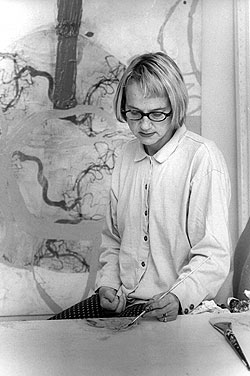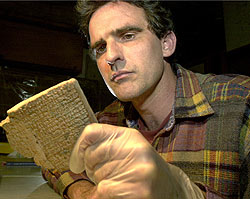Berkeleyan
Two Berkeley profs win Guggenheims
Sherwood and Veldhuis honored for past work and future promise
![]()
| 27 April 2005
Two Berkeley faculty members - one a noted artist who employs medical imaging in her work, the other an expert in Sumerian cuneiform writing - are recipients of Guggenheim Fellowships for 2005.
The awards - to art practice Professor Katherine Sherwood and Assistant Professor of Assyriology Niek Veldhuis - bring the all-time total of Guggenheims for Berkeley faculty members to 157. There were 186 artists, scholars, and scientists selected this year from more than 3,000 applicants from the United States and Canada. Fellows are chosen on the basis of past achievements and future promise.
Medical imaging and the spiritual
 Katherine Sherwood, professor of art practice, makes art that incorporates 'widely disparate' views of mental imaging. (Peg Skorpinski photo) |
"The simultaneous use of these widely disparate views suggests two revolutionary moments in our understanding and representations of the brain," wrote Sherwood in her Guggenheim proposal.
Those moments, she said, are the advent of a Western medical "humanism" that underscored the importance of understanding through dem-onstration and late-20th-century advances in medical technology that rely on a dematerialized, remote image of the human body.
"The purpose of this body of work is to reapply the use of such images towards an exploration of the spiritual vis-a-vis medical imaging technologies," Sherwood said in her proposal.
She said the work also will expand her research for "Art, Medicine, and Disability," an interdisciplinary class that she has taught at Berkeley for the past three years.
In 1997, Sherwood had a cerebral hemorrhage while teaching an art class on campus. She underwent extensive rehabilitation and changed some of her painting techniques to accommodate her injuries.
Of the use of her own angiograms in her Guggenheim project, Sherwood said that the pictures "illuminate my brain's arterial system, and my resolve to live."
Sherwood has participated in exhibitions around the world. In 2005 she was part of "Visionary Anatomies" at the National Academy of Sciences in Washington, D.C.; "Inside Out Loud: Visualizing Women's Health in Contemporary Art" at the Kemper Museum in St. Louis; and the Whitney Biennial in 2000. She's also shown her work in Japan and Thailand.
She received a National Endowment of the Arts Artist Fellowship in 1989, the Adaline Kent Award from the San Francisco Art Institute in 1999, and the University of California Bridging Grant in 2001.
The New Orleans native recently co-curated "Blind at the Museum," an exhibit at the Berkeley Art Museum that explored visual impairment, visual arts, and museums.
"I can't wait to be in my studio again full-time," Sherwood said about the work she has planned.
Between May 5 and June 5, Sherwood's art can be seen in a new exhibit at the Gallery Paule Anglim in San Francisco. More information about Sherwood and samples of her artwork are available on her website
(newscenter.berkeley.edu/goto/Sherwood).
Cuneiform as intellectual enterprise
 Guggenheim fellow Niek Veldhuis examines a cuneiform tablet in the basement of Kroeber Hall. The fellowship will allow him to think more deeply about the ancient texts he's spent so much time curating. (Noah Berger photo) |
Veldhuis, who joined the Berkeley faculty in 2002, will use the award to write a monograph on the intellectual history of Mesopotamia using ancient writings - known as cuneiform - of the Sumerians, who lived on the banks of the Tigris and the Euphrates in what is now Iraq. The Sumerian language died out around 2000 B.C.
Veldhuis, who is from the Netherlands, said he did not know exactly how prestigious the Guggenheim Fellowship was until enthusiastic congratulatory remarks started pouring in from so many people.
"I am, of course, very proud of it," he said.
Veldhuis said his monograph will add a crucial chapter to the world's understanding of intellectual history.
"Intellectual history traditionally begins with the Greeks," he said. "What I can show is that, long before the Greeks, there was a very different intellectual tradition going on two and a half millennia before Greeks even started to write."
Exploring the cultural context of cuneiform school tablets provides a different perspective on intellectual history, Veldhuis points out. Many of the cuneiform tablets may appear simply to list Sumerian names for birds or plant life or goods, but their importance actually goes much deeper.
"These lists, if you look at them in detail, are not about understanding birds but are about understanding Sumerian," he said. "This intellectual history is so different from what we think of as intellectual history."
For Sumerians, he explained, learning the complex and intricate system of cuneiform writing was in and of itself an intellectual enterprise.
Veldhuis' website, Digital Corpus of Cuneiform Lexical Texts (cuneiform.ucla.edu/dcclt), carries images and transliterations of cuneiform inscriptions once used to teach schoolchildren the fundamentals of the language and the writing system. He established the web project, which includes cuneiform texts from museums all over the world, so that scholars everywhere would have easy access to the data contained in these important texts.
But work on the project had left him little time to study the inscriptions themselves and fully explore their cultural context. "This fellowship will give me some time to go back to the intellectual aspects of this and think about the material I'm working with," he said.
Veldhuis received his bachelor's degree and doctorate from the University of Groningen in the Netherlands. He joined the Berkeley faculty in January 2002. Veldhuis and his wife, Marlies Rosmark, live in Richmond.
Last year Veldhuis received a grant from the National Endowment for the Humanities for his web project. In 2003 he received a Hellman Family Faculty Fund award, which supports substantially the research of promising assistant professors who show capacity for great distinction in their research.

